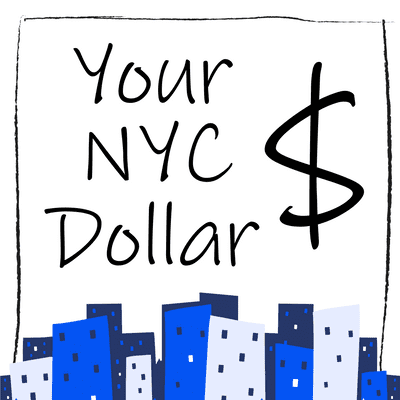
Your NYC Dollar
Podkast av Ben Greenback
Prøv gratis i 7 dager
99,00 kr / Måned etter prøveperioden.Avslutt når som helst.

Mer enn 1 million lyttere
Du vil elske Podimo, og du er ikke alene
Rated 4.7 in the App Store
Les mer Your NYC Dollar
Practical personal finance placing you on a path to financial independence.
Alle episoder
3 EpisoderOur Instacart definitive guide and shopping analysis, finds grocery delivery service fees, taxes, and tips add 20% to the food costs that may have a markup over in-store. Importantly, Costco offers the greatest value for consumers, followed by Aldi, Wegmans, and BJ’s. Remember, even buying through Costco from Instacart, you will still likely pay an average online markup of 15%, or more, versus in-store. Therefore, while it offers a nice aspect of optimization for a busy New Yorker, it is not the most frugal and economical source of groceries. GROCERY DELIVERY NEAR ME, NOW DAMN IT! We live in an instant gratification economy. While this might not necessarily be new, technological advancements are increasing the options for consumers. People increasingly want to use their smartphones via an app, or computer, to place orders online. For instance, they expect short delivery times, in a matter of days, if not the same day, more recently. Web-based services like Amazon Prime [https://www.amazon.com/amazonprime/], Netflix [https://www.netflix.com/], and Hulu [https://www.hulu.com/], among others, offer OnDemand movies and TV shows. Instant gratification provides significant value for consumers when done right, according to an article written in Forbes, What The Instant Gratification Economy Taught Me About Happiness [https://www.forbes.com/sites/ashikahmed/2017/07/10/what-the-instant-gratification-economy-taught-me-about-happiness/#43e2691c5932], by Ashik Ahmed. Within the article, he notes the following; > “In a world where consumers don’t just desire instant gratification, but expect it, the window for a startup to impress customers is smaller than ever.” Like many New Yorkers and others, for instance, you want to optimize your limited time. Oftentimes, this means paying a premium to have someone else provide a service that used to be part of daily routines. For example, this includes the premium an Uber [https://www.uber.com/] driver charges for door-to-door car service to some remote part of Brooklyn for a loft party. A shoeshine at Grand Central [https://www.grandcentralterminal.com/]. Dinner prepared by a restaurant and delivered from Grubhub. And our topic of today’s discussion, grocery delivery. Grocery delivery around New York City (NYC) is an increasingly competitive market spanning national services to those more regional. Moreover, there are options galore for consumers, and they appear to be increasing with time. For example, there are many grocery delivery services for NYC, including Amazon Fresh [https://www.amazon.com/alm/storefront?almBrandId=QW1hem9uIEZyZXNo], DoorDash [https://www.doordash.com/], Fresh Direct [https://www.freshdirect.com/], Grubhub [https://www.grubhub.com/], Instacart [https://www.instacart.com/], Peapod [https://www.peapod.com/], Postmates [https://postmates.com/], Shipt [https://www.shipt.com/], TaskRabbit [https://www.taskrabbit.com/], Uber Eats [https://www.ubereats.com/], Whole Foods delivery via PrimeNow [https://primenow.amazon.com/] and numerous others! We are going to focus on one service now, Instacart. Moreover, what are the lowest cost grocery delivery stores from Instacart in NYC? The goal is to provide a comprehensive analysis of the lowest cost grocery stores through Instacart as well as a definitive guide. Why? Because we need our guac, now! We are a needy species. HOW DOES INSTACART WORK? First, Instacart differs from some other grocery delivery services because it doesn’t have its own stores or warehouses. Rather, it creates relationships with your local grocery stores to offer a delivery service. Second, it merely acts as an intermediary for grocery shopping with no inventory to keep on hand. In addition, for those more community conscious, it drives local grocery delivery business to stores in your neighborhood. As a user, you gain value from the grocery delivery service, optimizing your life a bit, at a cost of course, while also continuing to support local stores and employment. Conversely, services like Amazon Fresh, Fresh Direct, Peapod, and others use their own networks of warehouses as the source for your grocery delivery. Instacart, however, utilizes its network of shoppers to visit your local store you have chosen to order from, gather items ordered, then deliver them to your doorstep. Time needed:20 minutes. Step-by-Step Guide for Getting Started with Instacart 1. Visit www.instacart.com [https://www.instacart.com/], or download the app (Apple app here [https://apps.apple.com/us/app/instacart/id545599256] or Android here [https://play.google.com/store/apps/details?id=com.instacart.client&hl=en_US]) for your smartphone or tablet. 2. Enter your email address and choose a password. 3. Input your zip code; this will let you know what local stores you can shop. 4. Select a store to start shopping. 5. Users can search for or browse items and explore different departments. 6. Select items you want, choose quantities, then add to your cart. 7. You can indicate replacement alternatives for items on low, or out of stock. 8. Special instructions may be added to orders for your shopper. 9. Go to checkout once you have finished shopping. 10. Choose your delivery window. 11. There’s also an option for leaving the delivery outside your door (unattended delivery). 12. Finally, enter your payment details and confirm your order. As an example, the video below provided on YouTube [https://www.youtube.com/] by Instacart provides a nice short overview of the process to get you started. https://www.youtube.com/watch?v=PksAfCz6akw&feature=youtu.be WHERE IS INSTACART AVAILABLE? Instacart provides service within various zip codes across cities located within all 50 states plus the District of Columbia within the US, in addition to some locations in Canada. The company provides broad service across New York State (NYS) and within NYC. That is to say, it includes all five boroughs of Manhattan, Brooklyn, The Bronx, Queens, and Staten Island. Take a look at Instacart’s grocery delivery service locations [https://www.instacart.com/grocery-delivery] on its website. You can enter your zip code or browse states and cities across the US, where they currently provide service. What happens if Instacart doesn’t deliver to me? You can still visit the same page [https://www.instacart.com/grocery-delivery]. Upon entering your zip code, you may choose to be notified when Instacart expands service to your location. WHAT STORES ARE AVAILABLE ON INSTACART? Available stores from Instacart will depend on your location, plus those that the company has a relationship with. Moreover, you can have a look at Instacart’s locations on its website [https://www.instacart.com/grocery-delivery]. Select your state, then city, or simply input your zip code. For instance, check for details on NYS [https://www.instacart.com/grocery-delivery/near-me-in-new-york]. Within NYC, there are several familiar faces when it comes to grocery store options. Likewise, these options will vary somewhat depending on your zip code, but many deliver to all five boroughs. Notable grocery stores include Aldi [https://www.aldi.us/], BJ’s [https://www.bjs.com/], Costco [https://www.costco.com/], CVS Pharmacy [https://www.cvs.com/], Fairway [https://www.fairwaymarket.com/], The Food Emporium, Key Food [https://www.keyfood.com/], ShopRite [https://www.shoprite.com/], Wegmans [https://www.wegmans.com/], Zabar’s [https://www.zabars.com/]. Additionally, local wine shops and liquor stores are often available. Above all, for the frugal shoppers, it is notable that Instacart provides service to Costco and BJ’s. Interestingly, you do not need to have a membership when using Instacart. If you do have one, enter membership information if possible to receive credit or other discounts. Sadly, for many, many New Yorkers, Instacart does not provide service for Trader Joe’s. HOW LONG DOES YOUR INSTACART DELIVERY TAKE? Many first-time Instacart users are curious about how long their grocery delivery order will take. However, this depends on a number of factors, including the availability of shoppers, as well as the demand for Instacart’s service. Excluding the pandemic of 2020, prior to that, Instacart could often deliver your grocery order the same day if you ordered early enough. Meanwhile, most recently, during the epidemic, grocery delivery services, including Instacart, have been overwhelmed with demand. As a result, orders have taken longer to fulfill. Nevertheless, over the past week, they seem to be consistently offering next day delivery in NYC. Also, you can set orders for delivery up to five days ahead. [https://yournycdollar.com/wp-content/uploads/2020/05/Picture-of-woman-delivering-a-package.--819x1024.jpg]Picture of woman delivering a package.For those who’ve taken to Twitter [https://twitter.com/] and other social media, to complain about grocery delivery times during the virus outbreak, shame on you. Certainly this is a high-class, first world problem. Above all, these complaints are disrespectful to all the workers on the front lines servicing you! INSTACART DELIVERY FEE, WHAT DOES IT COST? Fees for using Instacart vary and are rather broad. The short answer as to what is Instacart’s fees, is, well, that depends. Let’s cover some of the most common costs you’ll encounter using the service. Again, remember, using grocery delivery isn’t usually the most economical option, but it does offer an aspect of optimization and automation to your life. One opinion I’d like to share. I hate additional service fees! I’d also venture to guess some other folks out there would be in agreement based on some Twitter commentary. https://twitter.com/QJohanna36/status/995310175274840064Twitter commentary regarding the general disdain of service fees at Instacart.DELIVERY FEE The fee for delivery starts at $3.99 and moves up from there based on a combination of order size plus the scheduled time. Similar to Uber, if you are requesting delivery during a peak time, expect to pay a premium. Instacart does an excellent job notifying you if you are choosing a peak delivery slot. Refunds are possible for the premium delivery surcharge if your order happens to arrive late. SERVICE FEE & ALCOHOL FEE For everyone that is not an Express customer, there is a 5%, or minimum $2, service fee that applies to non-alcoholic items purchased. There is an additional service fee related to alcoholic purchases, as detailed in the table below, to cover additional costs, such as ID checking. Note, there is no service fee for pick up items. Non-MembersExpress Members$0-$35 of alcohol: $2.00 fee$0-$35 of alcohol: $0.80 fee$35.01-$75 of alcohol: $4.00 fee$35.01-$75 of alcohol: $1.60 fee$75.01-$110 of alcohol: $8.00 fee$75.01-$110 of alcohol: $3.20 fee>$110.01 of alcohol: $10.00 fee>$110.01 of alcohol: $4.00 feeInstacart alcohol service fee.HEAVY FEE If you’re purchasing bulk items such as cases of beverages and pet foods alongside others, then your order may incur another associated fee. This applies to orders, when these items deemed heavy, exceed 50 pounds. Users will be notified when this fee applies, and you’ll have an opportunity to adjust items if you want to avoid the extra cost before checkout. BOTTLE & BAG FEES The additional fees for bottles and bags are going to vary by state and localities. For those associated with bottles, check out www.bottlebill.org [http://www.bottlebill.org/] and look at www.ncsl.org [https://www.ncsl.org/research/environment-and-natural-resources/plastic-bag-legislation.aspx] for bag fees. TIPPING Instacart defaults the tip, 100% of which goes to your shopper-delivery person, at 5%, or the amount previously left by the customer. The company suggests a minimum of $2 per order. All tips are optional. However, basic etiquette suggests, if you cannot afford to tip for doorstep services, then you cannot afford them. [https://yournycdollar.com/wp-content/uploads/2020/05/Photo-of-glass-tip-jar.--1024x683.jpg]Photo of glass tip jar.Often a 10-20% tip, or $3-5 rule, is proposed, wherein tip the higher of 10% to 20% of the order or $3 to $5 minimum. Remember, Instacart shoppers are not hourly; they are paid a per delivery rate plus a per-item fee. This includes waiting in line at the grocery store, and drive time to your home! Consider leaving a tip towards the upper end of that range, or in excess, if you’ve ordered during the pandemic, inclement weather, or other unusual circumstances that are more demanding. SALES TAXES & OTHER Sales taxes and other fees are calculated the same as if you were shopping at the store location. Some locations may tax both delivery service and other fees incurred when ordering via Instacart. Be mindful; this is not all the fees incurred. There is also an Instacart Express members service we will cover, plus the most controversial and convoluted fee, the Instacart markup. INSTACART EXPRESS MEMBERSHIP For the frequent Instacart user, there is the Instacart Express Membership [https://www.instacart.com/help/section/360007797952#360039570171] option that might be worth exploring. The price for Instacart’s Express Membership is $9.99 per month or $99 annually. As an Instacart Express member, your delivery fees will be zero for all orders greater than $35. For instance, this cost usually runs around $3.99 to $7.99 per order. Additionally, it also reduces other service fees of about 5% per order and removes premium delivery costs during peak delivery time slots. However, I don’t see a reason to sign up for this immediately. I’d suggest you try the Instacart service a few times and determine if it’s right for you, before incurring another monthly or annual membership fee. THE POTENTIAL INSTACART GROCERY MARKUP Above all, the possible Instacart grocery markup is the most controversial fee associated with using the service. This Instacart fee is above and beyond all the previous ones detailed, and also the one with the least clarity for consumers. Hopefully, we can provide you a bit of clarity around this fee, what to look out for, and some context. Does Instacart charge more than my local store? The answer is, sometimes, but it is actually often the stores controlling pricing. https://twitter.com/michelletandler/status/1262080202567348224As you are shopping through the Instacart website or app, the prices you are shown at times reflect a markup premium above your local grocer; other times, they do not. You should take a moment and review Instacart’s pricing information page [https://www.instacart.com/help/section/360007902791#360039572851]. Essentially, what it says, is that grocers set the prices displayed by Instacart, and some of those stores may charge a premium versus in-store. Often this premium above the in-store cost is there to help defer the grocer’s cost for offering its products through Instacart. Nevertheless, this is often referred to as the Instacart markup when you come across it in social media or news. HOW TO CHECK THE GROCERS INSTACART PRICING POLICY Instacart where to check grocery store pricing policy on website to find potential markups. [https://yournycdollar.com/wp-content/uploads/2020/05/Instacart-Store-Pricing-Policy.jpg]Instacart where to check grocery store pricing policy on website to find potential markups. * First, go to the website or app. * Second, from the homepage, select a store. * Third, below the store’s logo, click the “Pricing Policy.” * Finally, here provides detailed information on potential markups over in-store prices. Same as In-store Prices?AldiNoBJ’sNoCostcoNoFairwayYesKey FoodYesMorton WilliamsYesShopRiteNoThe Food EmporiumYesWegmansNoInstacart NYC area common stores price policy vs in-store. How much is the markup from purchasing through Instacart if you have to pay? The company has commented before that, on average, the markup is around 15% or more. However, this is an average, and some consumers have found it extends well beyond this in some instances. When reviewing the stores’ Instacart price policy, some simply state that it varies, others explicitly note higher and some are the same as in-store. A word of caution here, don’t rush to purchase through Instacart at the grocery stores offering the same as in-store prices. In short, they don’t usually offer the best value. https://twitter.com/nicoleBans/status/781607571413053440Instacart markup that was rather crazy!Some previous analysis highlighted in an article at Supermarket News [https://www.supermarketnews.com/blog/how-instacarts-pricing-changes-impact-retailers] found that the Instacart markup was 23% higher than the in-store price. I would point out this is somewhat dated from early 2016, but likely still relevant. There are numerous other videos and articles online discussing markups that exceed the 15% average for Instacart. My advice, always check your final bill from Instacart so you understand all fees involved in addition to item prices actually paid. If something seems off, or crazy expensive, then get in touch with customer service immediately. Frankly, this is common sense advice to review your store receipts carefully anywhere you shop. Mistakes happen! INSTACART CUSTOMER SERVICE You have three options for quickly reaching Instacart customer service, all available on its contact page online [https://aboutinstacart.com/contact/]. Firstly, you can reach Instacart customer service by calling (888) 246-7822 [tel:8882467822]. Secondly, you may also email them at help@instacart.com [help@instacart.com]. Lastly, there is the Instacart Help Center [https://www.instacart.com/help] on the website. INSTACART GROCERY COST COMPARISON ANALYSIS Now we are finally getting into the value-add of this, how do grocery store prices compare on Instacart throughout NYC. We’ll gather together a shopping basket of similar items. Then we’ll run that through Instacart for various grocers throughout the five boroughs of NYC. Everything will be normalized with prices measured on a per unit, ounce, pound, or another relevant basis. We also aim to keep brands and sizes comparable across stores when determining unit prices to the extent possible. In addition to grocery prices, we’ll also tabulate and compare delivery and other associated fees. Lastly, any sales or coupons will be excluded as we are looking for the most comparable price across grocers within Instacart, consistently. THE DUMMY SHOPPING BASKET Firstly, our dummy shopping basket we have collected for our experiment includes many everyday items a consumer would purchase at the grocery store. Moreover, the goal is to have a basket of items that will be available across all the Instacart grocery stores we will check in NYC. Product selected at the various stores should be as fungible as possible, including brands, packaging weight, and quality such as organic and inorganic. These are all factors that could increase price variance within the same product categories. Worth noting, given recent shortages of meat, we have excluded this item from our shopping basket for this experiment. Additionally, we have excluded alcohol given not all grocers offered this through Instacart, sadly! Overall this should not have a significant impact on our analysis of grocery store prices across Instacart in NYC. The 15 items below are those included in our dummy shopping basket, for example. Dummy Shopping BasketBananasPepper Cheese BlockDiet Coke Cans 12 Fl ozFrosted FlakesGreek Yogurt Non-fat FlavoredRusset PotatoesItalian DressingAlmond Milk Vanilla UnsweetenedOrange Juice Tropicana Pure PremiumSpring Salad MixSpaghettiStrawberriesTostitos ScoopsBasmati RiceWhole Grain BreadDummy shopping list of common grocery purchases. Grocery Stores TargetedAldiBJ’sCostcoFairwayKey FoodMorton WilliamsShopRiteThe Food EmporiumWegmansInstacart grocery stores targeted across the five boroughs (not all inclusive).GROCERY STORE PRICES ARE CONSISTENT ACROSS THE FIVE BOROUGHS As we started to run our experiment, something unexpected occurred. Originally, we envisioned a breakdown of various grocery store costs, segmented across the five boroughs of Manhattan, Brooklyn, Queens, The Bronx, and Staten Island. In our hypothesis, we believed shopping through Instacart, at Key Food, for example, with the same basket of items, would yield different prices across different boroughs of NYC. Strikingly, this was not the case when we started to collect and compare the data. We checked a basket of items across both Costco, and Key Foods, for delivery addresses in Manhattan, Brooklyn, Queens, The Bronx, and Staten Island. There was no notable variance in price. For full disclosure, we did find a one-cent difference in the bag of Basmati Rice from a Costco in Staten Island, but all others were the same. As a result, we discontinued the same grocery store comparison from borough to borough, now working under the assumption that prices remained constant from each individual store within the city. INSTACART DELIVERY FEES DIFFER ACROSS THE FIVE BOROUGHS While the grocery basket of item prices did not show variance across the boroughs in NYC, Instacart’s delivery fee did change. We found this to be an interesting takeaway that was unexpected as well. It seems The Bronx is advantaged with a $3.99 Instacart delivery fee, based on an $89 order, that was lower, than the other four boroughs. So congratulations to The Bronx, 1520 Sedgwick Avenue, the birthplace of hip-hop, and home to low-cost Instacart deliveries. Instacart Delivery Fee Across Five Boroughs with The Bronx Lowest Cost. [https://yournycdollar.com/wp-content/uploads/2020/05/Instacart-Delivery-Fee-Across-Five-Boroughs.jpg]Instacart delivery fee across five boroughsINSTACART ALL-IN DELIVERY FEES INCLUDING TAXES & TIPS RUN AROUND 20% Ordering groceries via Instacart benefits users instant gratification neediness and allows them to optimize daily life a bit more. It does not offer the most economical option for grocery purchases, which we will touch on shortly. With that said, all-in Instacart delivery fees can add a significant cost to your food expenses. All-in Instacart fees include delivery, service, taxes, and tips. We assumed a 10% tip rate on all orders across grocers. Other fees varied slightly based on order sizes, and quantities of specific taxable items, such as soda, and other factors. Total Instacart Grocery Order Cost by NYC Area Stores Based on Sample Basket of Groceries [https://yournycdollar.com/wp-content/uploads/2020/05/Total-Instacart-Grocery-Order-Cost-by-Store.jpg]Total instacart grocery order cost by store.These all-in Instacart fees added between $13 to $38 per grocery order, for instance, mostly dependent on the weight, and quantities within the orders. Aldi was least at $13 in fees due to the lowest order value of $43, whereas Costco was greatest, with fees at $38, on the highest $156 purchase. Normalizing the data, and viewing costs on a percentage basis, all-in Instacart fees averaged about 20%. Due to our 10% tip assumed, roughly half of the all-in cost from ordering from Instacart is associated with tipping based on our dummy basket of shopping items. All-In Instacart Fees, Taxes & Tips Percentage of Total Order [https://yournycdollar.com/wp-content/uploads/2020/05/All-In-Instacart-Fees-Taxes-Tips-Percentage-of-Total-Order.jpg]All-in instacart fees, taxes & tips percentage of total order.Generally, placing larger value orders through Instacart results in a lower percentage of all-in fees. Looking at both the Costco and BJ’s orders, the two highest, all-in fees were some of the lowest, below the 20% average. The opposite is also sometimes, but not always true, with smaller order sizes. Aldi, the smallest order, actually incurred the highest percentage all-in fee at 23.6%. BULK WAREHOUSE GROCERS LIKE COSTCO & BJ’S OFFER VALUE THROUGH SCALE Shopping bulk warehouse clubs, like Costco and BJ’s, through Instacart, often offers some of the best value for consumers. Certainly there are economies of scale for these companies, and part of these savings are passed on to the consumer. Instacart Grocery Order Unit Price vs Total Order Weight Showing Bulk Grocery Purchases Often Save Consumers Money. [https://yournycdollar.com/wp-content/uploads/2020/05/Instacart-Grocery-Order-Unit-Price-vs-Total-Order-Weight.jpg]Instacart grocery order unit price vs total order weight.Bulk purchase options offered by warehouse clubs simply are not available elsewhere. This is what you’re paying for when paying your membership fee. But recall, when ordering via Instacart, you don’t need to be a warehouse club member. Alternatively, I have also found more limited choices of items when shopping at these warehouse clubs. That can be somewhat of a negative tradeoff. As a result of normalizing our purchases based on a dollars per unit weight, we were able to construct a graph comparing this versus the total weight of groceries purchased. What it generally illustrates is, buying greater quantities of groceries, results in lower unit costs. Note, however, this is not always true as we’ll touch on next. ALDI & WEGMANS OFFER VALUE FOR SMALLER PURCHASED QUANTITIES We found that despite smaller order quantities of grocery items, both Aldi and Wegmans can offer significant value for consumers. While each of these grocers through Instacart is slightly more costly than Costco, they are often lower or comparable to BJ’s. So for those New Yorkers, cramped for refrigerator and pantry space, which is a large portion of us, Aldi and Wegmans might offer a better alternative versus warehouses. Additionally, there is something to be said about food waste here too. According to the United States Department of Agriculture (USDA), its Economic Research Service [https://www.usda.gov/foodwaste/faqs] estimated 31% of US food, is lost at the retail and consumer levels, at an estimated value of $161 billion as of 2010. Generally, it is believed that between 30% to 40% of the US food supply is wasted annually. Similarly, the US Environmental Protection Agency estimated for 2010, each person, on average, wasted 218.9 pounds of food annually. I’m guilty of this myself, and my partner clearly reminds me, each time I place an order for Costco groceries. Three pounds of organic baby carrots is a lot! Let’s move on to the conclusion of our analysis. COSTCO, ALDI, WEGMANS & BJ’S OFFER BEST VALUE FOR CONSUMERS THROUGH INSTACART As a result of our analysis, looking at unit dollar costs by weight, utilizing a fungible food list of items across NYC grocers, we find that Costco offers the greatest value for consumers purchasing through Instacart. Instacart Grocery Store Unit Cost Comparison [https://yournycdollar.com/wp-content/uploads/2020/05/Instacart-Grocery-Store-Unit-Cost-Comparison.jpg]Instacart grocery store unit cost comparison.Costco likely benefits versus some other peers because of economies of scale, passing value on to consumers, plus its membership revenues, that in part, allow it to offer more competitive unit prices. Given Costco is the most competitive, for the basket of groceries, on a unit basis, it becomes our base measurement that will equate to 100. All other grocers will be benchmarked off this. [https://yournycdollar.com/wp-content/uploads/2020/05/Costco-sign.-1024x683.jpg]Costco sign.Next, coming in second, is Aldi, with its unit prices 5% higher relative to the Costco base. Frankly, I was impressed by this, but admittedly have limited knowledge of the grocer. Moreover, we previously had one near our old neighborhood but had patronized Costco instead of Aldi. Consequently, it is the same parent company to Trader Joe’s, there are many similarities between the two grocers. For instance, many items offered at Aldi, like Trader Joe’s, are a store brand as opposed to the name brand. As a result, this likely gave Aldi some edge in the analysis, given the lack of name brand items, and the need to substitute store brands in place of that. Moving on, both Wegmans and BJ’s generally remained low cost and provided good value for consumers. Prices are a little more than 20% higher versus Costco. Thereafter, prices tend to step up more considerably with other grocers. What I would call mid-cost grocers within Instacart, are Fairway, which was 43% higher cost than the base, and ShopRite that was 50% above. Rounding it out are the high-cost grocers on Instacart, including Food Emporium at 78% above the base, Key Food that was 90% higher, and coming in last, Morton Williams at 106% higher unit prices versus Costco. By the time we get to the highest cost grocer, a consumer is paying more than double the unit price to shop at Morton Williams through Instacart versus Costco. Above all, the Key Food ranking surprised me. I suppose this is because I frequently used neighborhood stores, living in various locations of NYC, since moving here. C’est la vie. Before rounding out our discussion on Instacart, we’ll touch on one last item for the hustlers of the world, employment. INSTACART SHOPPER, INSTACART DRIVER, INSTACART JOBS! Are you looking for a side hustle? Or perhaps a more permanent job? Have you considered jobs at Instacart? Check out the careers section of Instacart’s website [https://instacart.careers/]. According to its website, they have more than 300 retail partners, 200,000 shoppers across 5,500 cities. Based on recent news, I’d venture to guess this data is stale. According to a CNN article [https://www.cnn.com/2020/03/23/tech/instacart-hiring/index.html] late March 2020, due to surging grocery delivery demand amid the coronavirus, the company planned to higher an additional 300,000 employees creating significantly more Instacart jobs. So how much does Instacart pay shoppers? [https://yournycdollar.com/wp-content/uploads/2020/05/Woman-shopping-in-market-wearing-face-mask.--1024x683.jpg]Woman shopping in market wearing face mask.The Ride Share Guy [https://therideshareguy.com/instacart-shopper-pay/] recently interviewed an Instacart shopper in late April 2020, which provides some insights into wages during the coronavirus. Firstly, let’s touch on some terminology. Researching the roles, you will often hear them referred to as Instacart shopper and Instacart driver. In fact, these are one and the same, according to the company, that describes the role as a full-service shopper. This includes both the in-store shopping role as well as the delivery driving to the consumers’ doorstep. Technically there is an in-store shopper role at Instacart, but this is most often a part-time position. For instance, according to The Ride Share Guy [https://therideshareguy.com/instacart-shopper-pay/] interview, an Instacart full-service shopper delivering the groceries earns around $13 to $25 per hour in 2020. During the coronavirus, this has been closer to $25 per hour for the role. This includes what a worker would earn from Instacart plus tips. Additionally, there are sometimes bonuses for select cities where they need more employees. Importantly, I’d suggest checking out the website and read The Ride Share Guy’s writeup titled How Much Does Instacart Pay? [https://therideshareguy.com/instacart-shopper-pay/] [https://yournycdollar.com/wp-content/uploads/2020/05/Woman-pushing-shopping-cart-with-sunglasses.--769x1024.jpg]Woman pushing shopping cart with sunglasses.Not everything is rosy working for Instacart. One must consider the risks of these types of frontline jobs during the coronavirus. Additionally, according to a Vox article [https://www.vox.com/recode/2020/5/1/21244151/may-day-strike-amazon-instacart-target-success-turnout-fedex-protest-essential-workers-chris-smalls], workers at Instacart as well as Amazon and Target held a one day strike in May 2020, protesting for safer work protections amid the virus. Further, there was a bit of a debacle in 2019. It was found that Instacart was subsidizing employees’ hourly wages with tips customers were leaving, according to a Tech Crunch article [https://techcrunch.com/2019/02/06/instacart-ceo-apologizes-for-tipping-debacle/]. The company’s CEO has since pivoted, and now 100% of tips are provided to employees. More recently, some Instacart customers have been reportedly tip-baiting during the coronavirus. For example, the way it works is, according to a CNN article [https://www.cnn.com/2020/04/09/tech/instacart-shoppers-tip-baiting/index.html], a customer incentivizes an Instacart shopper to complete an order by offering an extraordinary tip, say $50. Once the order is completed by the Instacart employee, the customer then modifies the tip to something lower, or in some cases, to zero. https://twitter.com/oliverdarcy/status/1248660399127396352Reports of Instacart tips bait-and-switch during the coronavirus. This bait-and-switch is absolutely despicable, in my opinion. Instacart and other companies should stand up for their employees and begin banning users of this egregious practice during the virus. INSTACART PROMO CODE [https://yournycdollar.com/wp-content/uploads/2020/05/Window-sale-sign-pictured.--1024x683.jpg]Window sale sign pictured.Finally, there are several sources listed that can offer an Instacart promo code. Instacart Promo CodesBusiness Insider [https://coupons.businessinsider.com/instacart]RetailMeNot [https://www.retailmenot.com/view/instacart.com]Groupon [https://www.groupon.com/coupons/instacart]Coupon Follow [https://couponfollow.com/site/instacart.com]CNN [https://coupons.cnn.com/instacart]Instacart select promo codes for discounts. I publish and host my Podcast for Your NYC Dollar on BluBrry. If you enjoy my content, have a podcast or are starting one, consider signing up with Blubrry via this link offering a free month of service. I will earn a small commission that does not impact your purchase price.
How to prepare for a layoff? This is a question that nags me well after it happened in my life. Layoffs happen, that’s life, unfortunately (see my other article, Employer at the Gates… An Essay on Exiting the Workforce [https://yournycdollar.com/employer-at-the-gates-an-essay-on-exiting-the-workforce/]). Yes, it sucks! More so during the current coronavirus than in recent history, but one should prepare and remain focused on the next steps. Layoff preparation is key to minimizing the stress and adverse health effects associated with unemployment and maintaining some semblance of normalcy within your life while unemployed. Reflecting on my discharge that occurred around two months ago, I wish I had prepared better, and it had gone somewhat differently. The primary question I think about, how should I prepare for a layoff? Had I spent more time preparing for this event, perhaps inevitable in today’s economy, I would be on better footing when pursuing my next steps. We’ll cover fifteen pieces of advice I wish I had taken into consideration ahead of my cutback as I entered unemployment. We will cover mental and physical health preparedness to a greater degree than others may touch on because I feel it is crucial and often overlooked. First, let’s touch on some terminology. Picture of a dictionary with the definition of focus [https://yournycdollar.com/wp-content/uploads/2020/05/Picture-of-a-dictionary-with-the-definition-of-focus-1-1-1024x680.jpg]Picture of a dictionary with the definition of focusLayoff is when the employer discharges the employee. Often this action is the result of restructuring or cost-cutting and is synonymous with headcount reductions. Furlough, like a layoff, is a dismissal of an employee but differs as the individual usually returns at a later time to the position. Fire is when an employer terminates an employee due to poor performance or other causes. Usually, there is a greater negative connotation associated with being fired as opposed to furloughs and layoffs. Don’t fret; you can recover from this too! It is essential to understand the distinctions between the types of employment dismissals as this could impact your insurance benefits, like unemployment payments, as well as future references. With that understood, let’s move on to the fifteen pieces of advice, helping you prepare for a layoff. For brevity and those with limited attention spans, a summary table is provided below. LAYOFF PREPARATION CHECKLIST 1. Initial Shock May Overwhelm: Prepare for an emotional rollercoaster and shock associated with layoffs. 2. Seek Help if Necessary: Utilize benefits while still employed to prepare and address both physical and mental health. 3. Everyone is Expendable, Leave Arrogance at the Door: No employee is invaluable, stay humble in your career, or your ego may be crushed. 4. Get Your Office in Order: Literally, clear out excess personal items at work, including updating professional contacts via LinkedIn [https://www.linkedin.com/]. 5. It’s Not Personal, Usually: Employee reductions aren’t personal, although it will feel that way. It’s business focusing on the bottom line. 6. Capital Preservation is Not Market Timing: If unemployment is imminent, consider selling riskier assets like stocks and accumulating cash. 7. Understand Unemployment Benefits: Review unemployment benefits to see if you qualify, how much income it might provide, and for how long. 8. Never Stop Learning: Always continue your professional development via certifications or licensing while employed. It helps when looking for your next job. 9. Ask for More Severance: Strategize with a lawyer well ahead of layoffs and get them involved immediately to help negotiate a better severance. 10. Budget, Understand Your Expenses: Organize your finances, understand your income, cash flows, expenses, and debts. This helps you know the minimum cash requirements. 11. Cash is King, Emergency Fund Planning: Prioritize and build a six month or greater cash emergency fund in the event of layoffs. 12. Credit Optionality: Extend lines of credit and add new ones, not to the detriment of your FICO score. This will offer a credit cushion to utilize if you are unemployed longer than expected. 13. Maintain an Updated Resume: Always maintain, update, and revise your professional resume at least once a year and have a cover letter template on hand. 14. Always Interview & Network: While employed, continue interviewing for alternative jobs several times a year for practice. This may open new opportunities, and it won’t seem so foreign. 15. Be Less Committed to Your Employer: Yes, ensure the work you currently do is top-notch and respectable, but establish work-life boundaries. There are more critical things than pleasing a fleeting employer. 1) INITIAL SHOCK MAY OVERWHELM Before a layoff, understand how much of your life is genuinely tied to your employer and coworkers. While you cannot immediately change this, it will help better prepare you for the degree of emotional shock. You can also put forth some effort towards rekindling relationships unassociated with your job, reconnect with both new and old friends. Begin the process of decoupling your identity with your employer to mitigate the emotional impact of employment loss. There is no sugarcoating the emotional impact of losing employment. Losing your job envokes feelings of grief and is demoralizing while disorienting, all at the same time. It hit my self-esteem like few other things have in my life. During the first several days of unemployment, I suffered from insomnia. When I did manage to get some rest, I would wake up mourning my loss with a distinct feeling of sickness inside. The ordeal can be wholly immobilizing, and it is fair to say I was generally unproductive the first month. It was vital for me to ask myself why I felt such loss and better understand the dynamic behind the emotions. Picture of man stressed, sitting rubbing his eyes. [https://yournycdollar.com/wp-content/uploads/2020/05/Picture-of-man-stressed-sitting-rubbing-his-eyes.-1-2.jpg]Picture of man stressed, sitting rubbing his eyes.While millennials are often characterized as the job-hopping generation, in my case, I had been with my employer for almost ten years since first moving to New York City. The work was demanding and hours long, but also intellectually challenging in a way that caused one to become deeply devoted and involved with time. During a long tenure, even the most introverted of individuals like myself becomes friends with colleagues. These are the people I would spend the majority of my waking hours with, much more so than my partner, given the demanding hours. Beyond the workdays, it includes drinks afterward, business travel across the country, as well as birthday celebrations and other social activities. In short, I became close to my coworkers sharing much of my life with them. Neon sign saying work harder. [https://yournycdollar.com/wp-content/uploads/2020/05/Neon-sign-saying-work-harder.-1-1024x576.jpg]Neon sign saying work harder.My job had become my identity, and my colleagues represented much of my social circle. This identity and social circle came to an abrupt halt the day my employment ended following my sacking and was the catalyst prompting a waterfall of emotion after the fact. Everyone is different, and individuals who’s careers are less involved with larger social circles outside of work likely will not suffer as much of an emotional impact. 2) SEEK HELP IF NECESSARY For someone preparing for a layoff, it may be prudent to seek medical assistance. While still employed, review your benefits package and see what mental and physical health programs are covered and fully utilize them to the degree necessary. Develop a financial contingency plan post dismissal so you may continue these services as needed, perhaps on a more limited basis. Given the smorgasbord of emotions likely to flow after being let go as previously touched on, it could be beneficial to meet with a psychologist or psychiatrist ahead of the event and continue to do so after, so long as you’re financially able. Addressing mental health can help you prepare better psychologically while also discussing a plan for your next steps while unemployed. Ultimately, being mentally fit will smooth the transition and speed up the recovery process. Picture of prewar walkup building with a painted sign saying How Are You Really [https://yournycdollar.com/wp-content/uploads/2020/05/Picture-of-prewar-walkup-building-with-a-painted-sign-saying-How-Are-You-Really-1.jpg]Picture of prewar walkup building with a painted sign saying How Are You ReallyFor residents of New York, check out The Office of Mental Health [https://omh.ny.gov/] that includes telephone hotlines and other resources to get you started. At the federal level, you can look into The National Institute of Mental Health [https://www.nimh.nih.gov/health/find-help/index.shtml] and MentalHealth.gov [https://www.mentalhealth.gov/get-help]. Your preparation should extend beyond that of mental health and include your physical wellbeing too! Kate W. Strully [https://www.albany.edu/sociology/faculty/kate-w-strully], Associate Professor Sociology at University at Albany, has written on health implications from socioeconomic shocks of job loss. Within Job Loss and Health in the U.S. Labor Market [https://www.ncbi.nlm.nih.gov/pmc/articles/PMC2831278/] published in the journal of Demography Strully researches health implications from job loss within the United States. Photo of a doctor on his phone. [https://yournycdollar.com/wp-content/uploads/2020/05/Photo-of-a-doctor-on-his-phone.-1-1024x683.jpg]Photo of a doctor on his phone.Losing a job has been linked to increased risk of high blood pressure, heart disease, heart attacks, diabetes, as well as depression. Based on the research, when there is a job loss related to an employer closing, odds of an individual reporting fair to poor health increase ~54% while raising odds of a new health condition ~83%. Under a scenario when a person is fired or laid off, odds of reported fair or poor health increase ~80% and increases the odds of a new health condition by ~43%. The adverse health implications extend beyond unemployment, often continuing after finding new employment. So what can be done to minimize these physical health risks ahead of a dismissal? I would again suggest leveraging your employee benefits to the greatest degree possible before a layoff. Get an annual physical if you haven’t done so already. First, understand your key physical health metrics like blood pressure, weight, cholesterol, blood sugar, and others. If you’re unable to complete a physical schedule a call or appointment to discuss your most recent test results. Second, talk with your healthcare provider to understand what can be done with your diet, physical activity, sleep, and other things to improve your health. You may soon have plenty of time and no excuses for pursuing a healthier lifestyle when you’re not working! Once you’ve left your employer within the United States, there is usually an option to continue healthcare coverage for some time. Under The Consolidated Omnibus Budget Reconciliation Act (or COBRA) [https://www.dol.gov/general/topic/health-plans/cobra], workers are typically offered a choice to continue their previous health insurance after dismissal. The downside is that often this cost is only partially covered by your last employer or perhaps not at all. Healthcare in the United States is ridiculously expensive, so again, utilize your benefits to the greatest degree while you’re still employed. While the first two pieces of advice were mostly focused on the emotional and health aspects to prepare for ahead of a layoff, the remaining ones are focused on professional and financial preparations. 3) EVERYONE IS EXPENDABLE, LEAVE ARROGANCE AT THE DOOR I often see advice written to the effect of, make yourself too valuable to layoff. There was a demotivational poster I recall seeing titled Achievement, picturing the Egyptian pyramids with the subtext of “You can do anything you set your mind to when you have vision, determination, and an endless supply of expendable labor.” This statement rings true today in corporate America wherein companies are structured not to be heavily reliant on any one individual. Everyone is expendable, EVERYONE! I guess I’m an optimist! > “…check your arrogance and entitlement at the door. Remain humble in your career…” Several weeks before my departure, I recall a conversation with a coworker. The colleagues’ superior had recently left for greener pastures, and he was mildly overwhelmed with the workload but also relishing the fact his job was untouchable now. My view differed. While now there was limited redundancy in his role, I still felt the company would continue, the world would keep turning, and the sun would rise without him. Would there be frictional issues if he was not there and other peoples days more challenging? Sure. But ultimately some junior person would step in, or management would go externally, as it often does, and somewhere, for some level of compensation, a competitor would be willing to leave and step into the seat. We agreed to disagree. My advice is to check your arrogance and entitlement at the door. Remain humble in your career, but this is not to say let people walk over you or take undue credit for your efforts. You can be a humble yet authoritative individual while still helping others around you rather than becoming an arrogant asshat as your tenure progresses in your career. This mindset is something I tried to convey throughout my career. Yes, I believe you can make yourself a valuable member of the organization, indispensable, however, probably not! For those that don’t grasp this concept, a layoff is going to crush your ego. I have seen many rockstars in the business world that were very well regarded and looked up to be let go. 4) GET YOUR OFFICE IN ORDER When I advise you to get your office in order, clean up and get organized, I mean it in the most literal sense here. This process should be ongoing throughout your career at any employer and something I almost completely overlooked. Don’t accumulate too many personal things at work. Picture of organized office desk. [https://yournycdollar.com/wp-content/uploads/2020/05/Picture-of-organized-office-desk.-1-1-1024x658.jpg]Picture of organized office desk.If you feel layoffs are imminent at your employer, start reducing the amount of personal items in your cubical or office. Do this discreetly, taking a few extra items home in your backpack each evening, or coming in over the weekend to manage logistics on larger things. Take account of your professional contacts as well, business cards and contact information possibly stored in Outlook or another email client. When it comes to professional contacts, it may behoove you to implement some redundancy. LinkedIn [https://www.linkedin.com/], even the free version, is an excellent resource independent from your employer to catalog your network. In fact, it should probably be your primary way of keeping contacts. Make it part of your daily routine, when you meet someone during your career, set aside the business card or other contact details, then frequently allocate time to seek that individual out and connect with them on Linkedin [https://www.linkedin.com/]. Now you have a network of professional contacts independent from your employer that you can leverage upon leaving. Something to consider, if you are rushing to build out your LinkedIn [https://www.linkedin.com/] network at the last minute, this may become something of a red flag for coworkers. Several times I have received invites to connect via LinkedIn [https://www.linkedin.com/] from a longtime colleague, and within a few days or a week, they left. So be mildly cautious about sending a volley of connection invites to your current coworkers in a short period. > “…do not take any company property, intellectual or other…” When it comes to other digital data on your employer’s computer network, tread carefully. Go ahead and delete personal items such as passwords you have saved in a file, salary information saved on a drive, and personal tax documents. Do not attempt to remove data, client information, and prior work you have done while receiving compensation that is your employer’s intellectual property! While you may be emotionally attached to some work you have produced and proud of it, you should not remove it without the expressed permission of the employer. Most employers have sophisticated software monitoring your daily activity to varying degrees as well as regularly backing up the computer network. A previous manager I worked under noted when another colleague on our team gave his exit notice, the company asked him what aspects of his daily activity he would like monitored more closely. Despite never officially providing my personal email to my employer, upon my layoff before the subway ride was over, I received an email from human resources providing some detail on the explanation of benefits. The point is, do not take any company property, intellectual or other, with you upon your departure! 5) IT’S NOT PERSONAL, USUALLY Unless you were fired from your position for cause, a layoff or furlough usually is not personal. This does little to soothe your emotional reaction immediately but offers a more pragmatic view of the situation. Some people can relate to that more easily. > “Roles of managers and executives are multifaceted, and while most genuinely care about employees, part of their mandate relates to the corporation’s financial performance too.” Much of my prior job was spent analyzing other companies, understanding their fundamental drivers of earnings, or losses. Speaking with executives managing those companies, I have some sense of how they view the situation. It is true that layoffs are often about the bottom line of profitability; generally, restructurings aim to improve earnings. They were lowering business operating costs to generate more income for shareholders. These actions were often undertaking during times of cyclical economic headwinds, but not always. As a manager, one of the most manageable least frictional costs to reduce is headcount. Yes, I was sitting on the other end of that narrative and considered “headcount” and let go. Dow Jones Index graph pictured within a magazine. [https://yournycdollar.com/wp-content/uploads/2020/05/Dow-Jones-Index-graph-pictured-within-a-magazine.-1-1-1024x683.jpg]Dow Jones Index graph pictured within a magazine.It is not to say these managers or executives did not exhibit empathy. It feels cruel and callous to let a longtime employee go that has served the company well. Narrowly escaping a cutback earlier in my career, I had commented regarding the stress of the situation while meeting with the manager conducting the layoffs. His response was, “well, think about how all those people are feeling now that were laid off earlier today.” The point was undoubtedly valid and my comment tone-deaf and self-centered, but honestly how I felt. Later I would learn the manager had let go of a longtime mentee who had worked under him throughout several employers. The manager had taken this particularly hard emotionally. Throughout the course of my daily job when speaking with executives managing other companies, they always tended to exhibit some sort of empathy and remorse while reducing headcount. They were fully aware that their employees’ livelihood were disproportionately tied to employment if not wholly. Roles of managers and executives are multifaceted, and while most genuinely care about employees, part of their mandate relates to the corporation’s financial performance too. These aspects are not mutually exclusive and often conflict. An argument can be made these aspects do not conflict, there is more than the bottom line financially, but that is beyond the scope of this discussion. Anecdotally, in my years of researching corporations, I had only come across one company that maintained a no-layoff policy throughout economic cycles. Coincidentally, it is also viewed as best in class amongst its peers generating superior through-cycle shareholder returns. Food for thought I suppose. So look, you may be laid off soon or currently, but more often than not, this was not a personal issue. 6) CAPITAL PRESERVATION IS NOT MARKET TIMING The secular trend continues to move towards passive index investments versus actively managed funds. Index funds do not attempt to time the markets, although some individual investors may. I generally do not try to time markets. I’m more of the set it and forget it type, periodically rebalancing my portfolio. In the event you’re anticipating a layoff, you may want to rebalance and increase your bonds and cash holdings. > “Remember, it helps to reallocate your capital towards cash sooner than later during economic downturns to preserve capital.” When you enter the realm of the unemployed, you suddenly become more risk-averse. Now that you don’t have regular cash flows from income, you will naturally become more defensive about the capital you do have, aiming to maintain it holding less risky assets. Unemployment figures are higher during periods of economic headwinds or outright recessions, not to mention the current global situation that more closely mirrors the depression lasting throughout the 1930’s. During these periods, stock holdings tend to exhibit the greatest downside and volatility. Over periods of deep economic recessions, the duration of unemployment is often longer as well. I am not advocating a complete selldown of your equity holdings to less risky assets. On the flipside, downturns also offer some of the greatest upside potential for stocks when the recovery ensues. What I am suggesting, is that if you are anticipating a layoff, consider allocating any excess funds outside of your retirement portfolio away from stocks towards cash. How much should you allocate towards cash? Photo of many US dollar bills. [https://yournycdollar.com/wp-content/uploads/2020/05/Photo-of-many-US-dollar-bills.-1-1-1024x683.jpg]Photo of many US dollar bills.That depends on several factors. First, do you have another immediate employment opportunity lined up to replace the job you’ve lost? If so, you probably don’t need to worry about increasing your cash holdings. Second, how much do you already have saved in an emergency fund? Maybe if you have twelve months of cash to cover expenses, there is no need to sell stocks. If you only have a few months, then you may want to consider reallocating to cash. Third, if you have several sources of income, like a dual-income relationship or other sources from side-hustles, then there may not be a need to increase your cash holdings immediately. My advice is to assess your current situation as best you can and determine your resources. Continue this assessment during the period you are unemployed and modify it accordingly. Remember, it helps to reallocate your capital towards cash sooner than later during economic downturns to preserve capital. 7) UNDERSTAND UNEMPLOYMENT BENEFITS Heading into my layoff, I knew nothing about potential unemployment benefits offered by my new home state of New York. The last time I was unemployed was in my late teens, furloughed for a few months, while the company I worked at underwent renovations. From what I recall, the payments provided from my Midwestern state were minimal, given my modest wages at the time. The fact is, potential income from unemployment benefits was not factored into my emergency fund-scenario planning, so it was a modest positive surprise. Positive yes, but shame on me for not educating myself and planning better. Two men at a table reviewing documents. [https://yournycdollar.com/wp-content/uploads/2020/05/Two-men-at-a-table-reviewing-documents.-1-1024x683.jpg]Two men at a table reviewing documents.Each state within the United States offers varying degrees of unemployment benefits for most workers and layoff scenarios. Here is when being fired differs, in that you may be ineligible for benefits. Nevertheless, a quick Google search for unemployment benefits and your state’s name should yield fruitful results to get you started on filing a claim. For my fellow New Yorkers, check out The Department of Labor’s [https://labor.ny.gov/ui/faq.shtm] website for details on proceeding with a claim. There are also helpful facts and responses to frequently asked questions. First, determine if you are eligible for unemployment benefits within your state under a layoff scenario. Note, severance payments in either lump sum or over a period can impact when you can claim benefits. Second, there is a useful calculator available here [https://labor.ny.gov/benefit-rate-calculator/] for estimating your weekly benefit rate in New York. Remember, this weekly estimate is excluding taxes that you will have to either deduct from these payments based on your bracket or pay at a later date. > “Do not overlook unemployment insurance income benefits nor the potential out of pocket health care costs…” Note this weekly unemployment benefit excludes any supplemental payment associated with the coronavirus CARES Act [https://home.treasury.gov/policy-issues/cares] congress passed. Under this, it provides an additional $600 weekly, alongside the state benefits previously calculated, over April 5, 2020, through July 31, 2020 period. It also extends the number of weeks a person may claim unemployment benefits. The maximum period for claims under CARES is 39 weeks, up from 26 previously offered by states, until the end of 2020. Again, on the healthcare side, COBRA [https://www.dol.gov/general/topic/health-plans/cobra] typically offers an extension of your previous employer-offered benefits. Often a portion or all of this is at your own cost, however. Alternatively, you may be able to seek lower-cost benefits via the Affordable Care Act [https://www.healthcare.gov/] within the United States. Another possible option is signing on to your partner’s health insurance if they remain employed. Do not overlook unemployment insurance income benefits nor the potential out of pocket health care costs when planning for a potential layoff. 8) NEVER STOP LEARNING My advice of, never stop learning, while working in your current job, is not something I heeded myself. Frankly, I felt overworked with twelve-hour days and weekends the routine. While there were professional certifications I could have pursued, I never found, or perhaps made time, and became consumed with the day-to-day. > “…you are faced with a layoff, if you have worked on your professional development, you have something more to take with you.” In the early years of my career, I had started working on a professional certification for my industry. Started, then work would consume life, then stop. Rinse and repeat. Finally, after several misfires, I did complete the first module! Honestly, there was a deep sense of satisfaction when I did this, and I was quick to meet a colleague for a celebratory drink afterward. My suggestion, make time for yourself to continue your professional development during your career. Assuming this is important to you. If your current employer offers to pay for professional certifications or education, take advantage of it! People that I had worked alongside spent an enormous amount of time and effort to complete grueling certifications while working well beyond full time. It required commitment and diligence to be there long after coworkers had gone home as well as weekends. Kudos! Students pictured in a classroom. [https://yournycdollar.com/wp-content/uploads/2020/05/Students-pictured-in-a-classroom.-1-1-1024x683.jpg]Students pictured in a classroom.Is there a program that catches your eye, and you feel it is relevant to your career? Speak up and ask your manager if the company would cover the expense. Often if the employer is paying out of pocket, it is contingent on your successful completion of the program. So make sure you’re committed before moving forward. When the day comes, and you are faced with a layoff, if you have worked on your professional development, you have something more to take with you. It can be a resume builder and place you a step ahead of the pack when sitting down for your new interview. 9) ASK FOR MORE SEVERANCE Always ask for more severance than what your employer is offering in the event of a layoff. I am still kicking myself for not fighting harder. Had I prepared a bit more, my chances of success would have increased. > “Not getting a lawyer involved is my greatest mistake on this front. In fact, I should have had a strategy call with a lawyer years ago to discuss options in the event of a layoff.” When I left, I was offered close to three months of base salary, including some ongoing healthcare coverage. With a smile, the human resources person said, “We’re going to pay all of your accumulated paid time off within your severance.” My initial and current thought around this is go F-yourself! I had consumed any accumulated paid time earlier in the year. Not for vacation purposes per se, but rather exhaustion and depression. Understand that your severance agreement is designed to be mutually beneficial. The company is not paying you solely because they feel bad. Your agreement will often include non-compete details you should familiarize yourself with, clauses around defamation, and other stipulations you must adhere to that are beneficial for the company. What more should you ask for in a severance agreement? Someone at a table negotiating or providing their view. [https://yournycdollar.com/wp-content/uploads/2020/05/Someone-at-a-table-negotiating-or-providing-their-view.-1-1-1024x683.jpg]Someone at a table negotiating or providing their view.Ask for more money, base it on some rational, such as your years of experience will limit finding comparable alternative employment. Therefore, a new job will take longer to find. Request an extension on your employer covered insurance benefits. If it has been a while since you have sought employment, request outplacement, and resume writing services. If there are essential reports you had completed and proud of or other work, inquire if you may take some samples to aid in seeking new employment. Did your reviews go well during your tenure, then ask for the formal copies you could furnish to a future employer. How are you going to get any of this? Get a lawyer involved immediately, as in the same day you are laid off! Not getting a lawyer involved is my greatest mistake on this front. In fact, I should have had a strategy call with a lawyer years ago to discuss options in the event of a layoff. This can help you understand your legal options and recourse, if any, well ahead of time. Most importantly, it provides you some serious leverage in the days after your layoff before you sign the agreement. In my situation, I had additional requests for more compensation in my severance agreement. In my exit meeting, if you could call it that, the request was immediately passed on to the legal department. I was informed on my subway ride home via email. By the time I was home that first day, I was overwhelmed with emotions related to losing my job and anxious. Woman in bed. [https://yournycdollar.com/wp-content/uploads/2020/05/Woman-in-bed..jpg]Woman in bed.I waited… And waited… Then a few days had passed, and I emailed human resources to inquire about the additional severance. They did not respond that day, but the following, informing me they would inquire with the legal team regarding the request. They were stonewalling me. I believe they were waiting to see how I would respond. Did I seek advice and get a lawyer involved? Better, did my lawyer contact them directly? Nope. My former employer knew they could play a waiting game and see how I would react, or not. The clock was ticking, and they knew I had around a week to respond, so no need to rush their response, right? They were not incentivized to pay any additional severance because my request did not have teeth. Had they felt there was the risk of legal recourse and related expenses I believe they would have been more amenable. In the end, they denied the request, and my time to respond was limited by that point. I signed the boilerplate agreement and moved on. 10) BUDGET, UNDERSTAND YOUR EXPENSES As part of your personal finances, you should be budgeting. Budgeting is a topic unto itself, but you should have a cursory understanding of it, yesterday. For reals, get your ass moving! At a minimum, start tracking your expenses, cash flows, plus assets, and liabilities today! Man viewing a tablet with various graphs. [https://yournycdollar.com/wp-content/uploads/2020/05/Man-viewing-a-tablet-with-various-graphs.-1.jpg]Man viewing a tablet with various graphs.There are plenty of automated to semi-automated platforms out there, with many free to use. Sit down, collect all your credit cards, bank accounts, mortgage, brokerages, and other financial assets and liabilities. Then input all this data linking accounts into one or more of these platforms. A few platforms to track your finances are listed below, and those more ambitious can pursue a manual process within spreadsheets [https://www.google.com/sheets/about/]. Mint.com [https://www.mint.com/] PersonalCapital.com [https://www.personalcapital.com/] YouNeedaBudget.com [https://www.youneedabudget.com/] Quicken [https://www.quicken.com/personal-finance/budget] In preparation for a layoff, this financial information will be crucial to your planning and budgeting. The more history you have here, the better. You can see your baseline expenses, and this will help determine your emergency fund. You will also be able to review the trends and understand what expenses are nonessential and can be reduced or outright cut during a period of unemployment. Gain a realistic understanding of your bare-bones monthly expenses you may incur in the event you’re laid off. 11) CASH IS KING, EMERGENCY FUND PLANNING Conventional personal finance wisdom suggests holding six to twelve months of cash to cover expenses in an emergency fund. From my personal experience, holding around six months in cash reserves, I wish I had doubled it. That’s not to say I don’t have other resources. I can liquidate a personal brokerage account. But honestly, who wants to do that when stocks are down -30% from peak? This is sort of the point of emergency cash reserves. During periods of financial constraints, there is a good chance your portfolio is down considerably, and you are less inclined to liquidate those assets. Your first line of defense is that emergency fund during unemployment. The larger the holdings, the greater your optionality and potential runway to cover expenses while out of work. Emergency ambulance pictured driving. [https://yournycdollar.com/wp-content/uploads/2020/05/Emergency-ambulance-pictured-driving.-1-1024x683.jpg]Emergency ambulance pictured driving.On the other hand, and the argument against significant emergency fund holdings, there is limited appreciation of cash balances held. More so, over recent history within the low-interest-rate environment. So you forego greater return potential than if you had allocated most of those cash emergency funds towards asset classes like stocks or bonds in the first place. You will need to determine your appetite for risk and consider other financial resources available when setting a target balance for your emergency fund. More than likely, as you accumulate more wealth with time, you can likely reduce your emergency fund because you have more alternative resources available to you. If you feel a layoff is imminent, the best plan is likely maximizing your emergency fund contributions near term while curtailing contributions elsewhere to retirement or excess mortgage payments. 12) CREDIT OPTIONALITY Besides a mortgage, I tend not to hold debt balances past one month. I worked too hard for over a decade to largely become debt-free. That said, I believe credit cards and other lines of credit have their place. In short, credit can provide optionality during times of uncertainty and while unemployed. Determine if you feel a layoff is imminent. If you don’t feel there is a high dismissal risk over the near to medium term, then you can continue to pay down debts, assuming you have first amassed some cash emergency fund. However, during uncertain economic times, if there is a higher probability of discharges, then immediately pivot to paying minimum balances for your credit obligations, including mortgages. Conserving and growing cash under this scenario is your top priority. Credit cards pictured in a wallet. [https://yournycdollar.com/wp-content/uploads/2020/05/Credit-cards-pictured-in-a-wallet.-1-1024x683.jpg]Credit cards pictured in a wallet.Even before this occurs, understand and expand credit available to you. Explore increasing credit lines with banks if possible, where you have longstanding relationships. If you own your home and a home equity line of credit is available (HELOC), then consider putting that in place. Check if your retirement savings, 401K or other, has options wherein you can borrow against it and repay yourself over time. The idea here is you create the greatest possible optionality and access to credit while being mindful not to harm your FICO credit score meaningfully. Increased lines of credit during unemployment can provide an extra financial cushion in the event you need it, but you should utilize other resources first. Another point, if you find yourself facing financial hardship and anticipate falling behind on bills, discuss this with creditors. Call them and keep lines of communications open. Many times they have departments that are willing to help and discuss other options during hardships. Along the same lines, if recently let go during a recession, check online or call your credit issuers and ensure your credit availability has not changed. There has been some recent news that creditors were reducing availability without prior notice. 13) MAINTAIN AN UPDATED RESUME When you have been at a single employer for some extended period of time, an updated resume may fall by the wayside. Avoid this! At least once per year, if not more often, make sure you are updating and revising your resume as if you had to use it tomorrow. > “While I was reasonably diligent in keeping my resume up to date while employed, it has been years since I had to write a cover letter—almost fifteen.” Review it and incorporate new accomplishments during your career. Drop off items that become less relevant with time. Ten years into your career, it is unlikely anyone will care that you were president of the chess society during college. LinkedIn [https://www.linkedin.com/] can provide a good framework for your resume, but it should extend well beyond this, providing more granular details of your activities and accomplishments. While you’re still gainfully employed, perhaps consider paying a professional resume writing service next time you refresh it. It may be worth exploring as you advance through your career and the expense more palatable when you’re generating income. Conversely, it is unlikely you would be willing to spend money on a resume writing service while unemployed. Coincidently, this being the precise time you could leverage a new resume most! If you do pursue a professional resume writing service, I would suggest you have them work with you on a cover letter template. Or perhaps several based on various positions targeted. While I was reasonably diligent in keeping my resume up to date while employed, it has been years since I had to write a cover letter—almost fifteen. I wasn’t even sure if employers still asked for cover letters today, but it turns out several of them still do! I was at a loss, no template, no nothing, and quickly engaged Google for guidance. 14) ALWAYS INTERVIEW & NETWORK As previously alluded to, it has been almost fifteen years since I had to formally interview for a new job. While I have engaged with several headhunters during my career and crossed paths with competitors recruiting, I have not interviewed in years. It. Is. Frightening! Several years ago, I read an article that suggested professionals should interview for potential jobs at least once every six months. I unquestionably did not heed this advice! In retrospect, I fully understand this guidance, but being the introvert I am, I never pursued it to my detriment. Candidly, it wasn’t all about being introverted, but rather, since day one of my career it has been like drinking from a firehose. Completely overwhelmed and underwater, barely enough time to breathe. While I failed at the always be interviewing mandate, I mildly succeeded at the networking aspect. LinkedIn glass office door pictured with company logo. [https://yournycdollar.com/wp-content/uploads/2020/05/LinkedIn-glass-office-door-pictured-with-company-logo.-1-1024x683.jpg]LinkedIn glass office door pictured with company logo.Somehow, I fumbled my way through networking with colleagues, people at industry events as well as several competitors. I was better about connecting with these people via LinkedIn [https://www.linkedin.com/]. In fact, several years ago, I set a reminder on my work calendar to network via LinkedIn [https://www.linkedin.com/]. My goal was each Friday to spend ten to fifteen minutes browsing suggested contacts and adding those I worked alongside and others within the industry or close clients. One piece of advice here, if you plan to stay in your career, try to connect with managers or executives at competitors. These individuals are generally receptive and open to connecting. A simple note, introducing yourself and perhaps a coffee at a later time, is enough to kindle a relationship. I have seen many future jobs sprout from old connections like these years later. When I was unemployed, some of these people, as well as former coworkers, were the most receptive. It provided a mild sense of comfort in an otherwise chaotic time. 15) BE LESS COMMITTED TO YOUR EMPLOYER My most important lesson and piece of advice from my layoff ordeal? I wish I had been less committed to my employer. That isn’t to say I shouldn’t have done good work I was proud of nor endure long hours. Rather, I should have established clearer boundaries between my personal life and that of my career. Constantly, projects felt like it should have been done yesterday, was of the utmost importance in my life, and prodded, pushed, and pulled forward by managers and clients; it does not matter today. The top priorities of yesterday are nowhere to be found today, unemployed. Neon sign pictured above a woman stating slow down. [https://yournycdollar.com/wp-content/uploads/2020/05/Neon-sign-pictured-above-a-woman-stating-slow-down..jpg]Neon sign pictured above a woman stating slow down.That part of my career is over, and while I can carry the knowledge and experience with me, all that stuff I produced is left to die on a server in the cloud. I regret not spending more time with my partner, focusing on my health, nurturing activities, and interests outside of my career. The good news is, I’m unemployed, and presumably, I have some life ahead of me! Grammarly’s artificial intelligence aided in the editing of my article. Perhaps it can help you! Consider clicking this link to support my work wherein I will receive a commission for your purchase. Layoff Checklist by Your NYC Dollar [https://yournycdollar.com/wp-content/uploads/2020/05/Layoff-Checklist-by-Your-NYC-Dollar-410x1024.png]Layoff Checklist by Your NYC Dollar
THE PANDEMIC SHOULD MARK A TURNING POINT IN EMPLOYER-EMPLOYEE RELATIONS Author William Craig’s Enemy at the Gates: The Battle for Stalingrad [https://www.amazon.com/Enemy-at-Gates-Battle-Stalingrad-ebook/dp/B013S434Y8], details the German invasion of Stalingrad in 1942 during World War II. Invading forces believed overtaking the city post bombings could be done with relative ease; however, it lasted over five months, and almost two million lives were lost. Historians view it as a turning point of the war, a view I hope prevails after the pandemic regarding employer-employee relations. > “The government and institutions will rain praise on first responders and everyday people for diligently fighting the virus.” An article on Medium [https://medium.com/] titled Prepare for the Ultimate Gaslighting [https://forge.medium.com/prepare-for-the-ultimate-gaslighting-6a8ce3f0a0e0] by Julio Vincent Gambuto more eloquently detailed the gaslighting that likely ensues once the government and corporate America deem it essential the economy restart. Millions under stay at home orders, furloughed or outright laid off will be encouraged to go back to work. It is for the greater good as well as your wellbeing to reengage the workforce and stimulate an economic recovery. The government and institutions will rain praise on first responders and everyday people for diligently fighting the virus. Now is the time to put your best foot forward and bring back some normalcy to daily life. Right? Like many others across the country and globally, I was not immune to the pandemic and found myself unemployed. The more time that passes has led to self-reflection about what my life was before and where an idealistic version saw it as well as a more pragmatic assessment looking ahead. > “Take some time to assess your life and the employer-employee relationship.” I hope others reflect on their situations during this time, and something more comes of it, specifically the employer-employee relationship. For those of us out of work or remote, employers will be keen to have us back once the green light is given. Back to what? Did the employers care about my livelihood and work in my best interest during the pandemic? Before that, did they have my best interest in mind and provide livable wages while sufficiently saving for retirement? Were their actions before, during, and after the pandemic merely lip service to paint themselves in a better light? Take some time to assess your life and the employer-employee relationship. This situation is painful to many of us for various reasons, including the deaths of loved ones and those around us. I feel fortunate those around me have remained healthy or overcome the virus, but my circumstance of being let go still aches. THE INVISIBLE HAND HURTS Adam Smith wrote on the concept of the invisible hand in The Wealth of Nations [https://www.amazon.com/Wealth-Nations-Introductions-Belfort-Seligman-ebook/dp/B01NA0NQN1/ref=sr_1_1_sspa?crid=2A63ALOOIGK3O&dchild=1&keywords=wealth+of+nations&qid=1587593799&s=digital-text&sprefix=wealth+of+%2Cdigital-text%2C163&sr=1-1-spons&psc=1&spLa=ZW5jcnlwdGVkUXVhbGlmaWVyPUFIT1EySkhJU0tYV04mZW5jcnlwdGVkSWQ9QTA3Mzg3MzYxSzNLVDM0Q0VYTVJRJmVuY3J5cHRlZEFkSWQ9QTAyMTgwMTY1UFdBOENWSjZGSFomd2lkZ2V0TmFtZT1zcF9hdGYmYWN0aW9uPWNsaWNrUmVkaXJlY3QmZG9Ob3RMb2dDbGljaz10cnVl] in 1776, a metaphor on unseen forces that drive free-market economies. Freely exchanged goods and services allegedly bring value to the market. Changes in output, supply and demand, ultimately find a market equilibrium with time. As it turns out, the free-market economy determined my labor no longer held value several months ago as demand plummeted, and like many others, I was unemployed. In March of 2020, around lunch, I was called in my office to meet management in a conference room. During that initial call, I already knew what it meant, exclaiming, “well, this can’t be good.” The voice on the other end of the phone concurred, “you may be right.” Despite modest preparation, both consciously and subconsciously, since the day I started my career, it was still shocking. Newspaper clipping highlighting COVID-19 Layoffs [https://yournycdollar.com/wp-content/uploads/2020/04/COVID-19-Layoffs-2.jpg]Newspaper clipping highlighting COVID-19 Layoffs> “My job had become my identity.” The experience of being let go is demoralizing, hits you in the gut, and crushes your self-esteem. Sleeplessness persisted for several nights after. Over the following month, my mood would swing from the elation regarding the opportunity of starting a new chapter in life and drift back towards grief over the loss. My job had become my identity. Often, I still wake up early in the morning, nauseous over my job loss, with my subconscious still reeling throughout the night. A quote mistakenly attributed to Churchill said something to the effect of move past failures with no loss of enthusiasm. The point being, one must move on and try again while maintaining a positive attitude. I’m not there yet, but I am making a concerted effort to reassess my options. THIS IS WHAT I KNOW… THE RUSH BACK TO YOUR IDENTITY Almost immediately after losing my job, I was trying to replace it. Within one day of leaving, I was upgrading to LinkedIn [https://www.linkedin.com/] premium, shooting off emails to prior colleagues and people within my network. All of this, to fill the void, moving back to a position of normalcy in life. It feels off. Did I want to go back to that routine that consumed my life? Look, there was a lot that I truly enjoyed about my job. It was demanding and dynamic. Global news flow and the economic narrative driving the market keeps you on your toes. Colleagues were generally likable, many becoming friends of mine over the years. Those around me throughout my career were generous with their time, helping me and many others learn along the way. Conversely, there was plenty I came to loath about my position. Headcount reductions throughout the years pushed what seemed like a mountain of work on my desk. It evolved into a never-ending list of things to get done. I felt the need to be working on projects not only Monday through Friday, but also evenings when I would get home. Weekends were more often than not another workday, at least in part. My capacity was full, and I had no excess bandwidth to take on additional work without help. This situation gradually led to depression. No matter the hours of effort I put forth, I was unable to complete everything and felt increasingly despondent with the situation. Near the end, I felt like I was possibly turning a corner, getting some additional help, but still felt my career consumed my life. Beyond catching a movie at home in the evening, there was little else outside of work anymore, no semblance of work-life balance. I’M NOT A NIHILIST DONNY… WHAT ELSE DO I CARE ABOUT? Several years after moving to New York City, around 2014, I became interested in my personal finances, specifically the lack of focus as well as a plan. An avid consumer of information, I scoured books on Amazon as well as articles online from business publications and blogs. One book, in particular, stood out, If You Can: How Millennials Can Get Rich Slowly [https://www.etf.com/docs/IfYouCan.pdf] by William Bernstein. It is free and worth the read. While I will not bore you with the details, needless to say, I did develop a plan to address my lack of financial wellbeing. Debts were repaid. An emergency fund was started. Over several years I continued to focus on improving my financial situation and research the subject. Personal finance evolved into a hobby of mine. > “After leaving my job, I had to take inventory of my skills.” This contrasted with my career focusing on helping others pick stocks, understand companies and their industries. These people were individual stock pickers; I became an index investor. I tend to agree that most investors nor funds beat the market over time. After leaving my job, I had to take inventory of my skills. Not all the day to day in my career contrasted with personal finance. I was an avid writer capable of distilling complex ideas and analysis into easily digestible content for people with minimal attention spans. It would be rare if I would finish a day without writing, often extensively. I found myself genuinely passionate about personal finance, improving my situation as well as helping others. PARLAYING A SKILLSET, AN EXIT OPPORTUNITY Letterbox sign stating Think Outside the Box [https://yournycdollar.com/wp-content/uploads/2020/04/Letterbox-sign-stating-Think-Outside-the-Box-2-674x1024.jpg]Letterbox sign stating Think Outside the Box> “I have lower case f-you money, not upper-case F-you.” Several holidays ago, I tossed around the idea of writing about personal finance. I went so far as to register a domain and began learning about publishing online. This initiative was thrown to the back burner during a prior round of layoffs. This was common within the industry and at my previous employer, not to mention nerve-racking. More work was placed on my desk. There the idea sat until a few weeks ago. First, I feel fortunate to have the opportunity to pursue a different path. I am not financially independent. I have lower case f-you money, not upper-case F-you. My safety net likely only lasts six to twelve months. While there was undoubtedly a significant amount of hard work and savings associated, many others suffering from unemployment are not fortunate. That does not escape me. > “…my primary priority is improving financial literacy for others around New York City and elsewhere.” Second, my next endeavor intends to help people across socioeconomic backgrounds become more financially literate, stabilize their situation, improving it, placing them on a path towards financial freedom and independence. Alongside this, I am setting forth some financial goals to keep me afloat. Through a combination of writing on my website plus other publications like Medium [https://medium.com/], potentially publishing a book, counseling others as well as investing and building my passive income and wealth. Is this a feasible exit opportunity? Neon sign stating Change [https://yournycdollar.com/wp-content/uploads/2020/04/Neon-sign-stating-Change-1024x576.jpg]Neon sign stating “Change“Who knows, but I feel it is achievable, and my primary priority is improving financial literacy for others around New York City and elsewhere. From an economic perspective, I aim to replace my lost income I would achieve reengaging the job market. Moving forward, I intend to provide frequent updates on my progress or lack thereof and hope we learn a bit along the way. I wish others will take some time and reflect on their careers if they are afforded the opportunity during this period and assess the employer-employee relationship. Question it and fight for equitable change that is mutually beneficial. Welcome to the journey, and stay safe! Man dressed for work in sport coat, jeans with briefcase & book [https://yournycdollar.com/wp-content/uploads/2020/04/Man-dressed-for-work-in-sport-coat-jeans-with-briefcase-book-1024x1024.jpg]Man dressed for work in sport coat, jeans with briefcase & book

Rated 4.7 in the App Store
Prøv gratis i 7 dager
99,00 kr / Måned etter prøveperioden.Avslutt når som helst.
Eksklusive podkaster
Uten reklame
Gratis podkaster
Lydbøker
20 timer i måneden

































